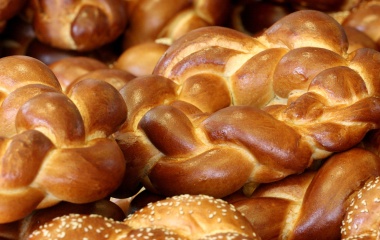
“Now it came to pass after many days, that Cain brought of the fruit of the soil an offering, a mincha, to the Lord” (Breisheet 4:3).
The first korban recorded in the Torah is not an animal offering, but rather a korban mincha, brought from the fruit of the land. Cain's korban was immediately followed by that of Hevel, who brought “the choicest of his flock”. Yet despite the fact that Hevel brought an animal and not produce, the Torah tells us that “G-d accepted the mincha of Hevel”. Mincha, meaning “gift”, is the generic term for all korbanot, regardless of what they may consist of.
In sefer Vayikra, korban mincha takes on a specific meaning, referring to those sacrifices brought from flour—as opposed to all other types of korbanot, which require that one offer an animal[1] .
The korban mincha is the least expensive and simplest of the korbanot to bring. G-d does not need us to bring Him big gifts; a simple handful of flour is just fine. What He does want is sincerity, that we have the best of qualities, that of "a good heart" (Pirkei Avot 2:8). Our Sages understood that this was the difference between the offerings of Cain and Hevel. Cain may have brought a more expensive korban, but it was Hevel who offered G-d the best that he had. How we bring the korban is much more important than what we bring as a korban.
Thus, the opening Mishna of Menachot teaches that one who brings a korban mincha shelo lishma[1], not for its own sake, does not fulfill this obligation and would be required to bring a second korban mincha. The closing Mishna of Menachot teaches that “it matters little whether one offers much [i.e., an animal] or little [i.e., flour] so long as one directs one’s heart to heaven”. G-d is not impressed by displays of wealth; it is the heart that interests Him most.
Tellingly, this same idea also serves as the opening Mishna of masechet Zevachim, which teaches that one who brings an animal korban shelo lishma does not fulfill this obligation and would have to bring a second korban. Considering that our rabbis generally tried to avoid repeating themselves, the teaching of the same law in back-to back masechtot is a powerful lesson that, at least when it comes to G-d, it is quality, not quantity, that matters most.
With prayers being a partial substitute for korbanot, this same principle applies there, too, such that one who prays without focusing on what is said is obligated to pray again. In practice, we do not follow this approach—not because anyone disagrees, but because we are afraid that we would have to spend many, many hours a day davening until we could be confident that we davened with proper kavanah (see Shulchan Aruch, Orach Chaim, 101:1).
Like an animal sacrifice, a korban mincha has four basic steps: kemitza, the taking of a fistful of flour (corresponding to shechita, the slaughtering of an animal); putting the flour into a consecrated vessel; walking it over to the altar; and placing it on the fire. It is these four activities that must be done lishma, with the proper intent.
There are both communal and individual korbanot Mincha, as well as those of an obligatory nature and those brought voluntarily.
The most common mincha was the minchat nesachim, the libation mincha. Mixed with oil (as were almost all menachot), the mincha, along with wine to be poured on the side of the altar, was brought together with the korban tamid, the communal daily animal offering. Similarly, a korban shelamim and the sin offerings of the metzora were also accompanied with a minchat nesachim.
Probably the most well known of the korbanot is the korban omer brought on the second day of Pesach. It was the debate surrounding the proper timing of this korban—the Sadducees argued that it was always to be brought on a Sunday—that eventually led to the establishment of the second day of Yom Tov in the Diaspora. The bringing of the korban omer allows us to eat from the grains that were planted in the past year. The korban haomer brings with it the obligation of sefirat haomer and 50 days later, the shtei halechem, two large loaves of bread, are brought to the Temple. As the korban haomer allows us to consume the new grains, the shtei halechem allows the new grains to be offered in the Temple.
With barley being the first of the grains to ripen in early spring and the wheat harvest beginning some seven weeks later, these korbanot consisted of barley and wheat respectively, serving to thank G-d for the blessings of land. The third of the communal menachot was the lechem hapanim, consisting of twelve loaves of bread. These were cooked fresh every Shabbat, left on the shulchan, the golden table next to the menorah, during the week and eaten the following Shabbat.
The most tragic of the individual korbanot mincha—the mincha kenaot, the korban of jealousy—was brought by the sotah, the wife about whom there was good reason to suspect adultery. Her sacrifice was to be brought from barley and was to have no oil or frankincense added to it, because: “Just as her actions were the actions of an animal, so, too, her sacrifice is the food of an animal” (Sotah 14a).
There were three instances in which one who is meant to bring a korban chatat but could not afford it was afforded the opportunity to bring a korban mincha instead. These were: one who enters the Temple area, or eats of a korban while in a state of tumah, due to having recently come in contact with death; one who is subpoenaed to testify, denies under oath of possessing any evidence and then admits that to lying; and one who violates an oath that they have taken.
The kohen gadol had to bring a minchat chinuch, on the day he was appointed to his post, as well as minchat chavitin, a pan offering, brought daily—half in the morning and half in the evening.
In addition to the above-mentioned obligatory korbanot, one could volunteer, as a form of thanksgiving, to offer a korban mincha.
When bringing a korban mincha, a kometz, a fistful, was to be offered on the altar with the remaining part eaten by the kohanim only. However, when a kohen brought the korban, no one could partake of it. With the exception of the shtei halechem and the mincha brought with a korban todah, a thanksgiving offering, the Torah forbade the korban mincha from becoming chametz. Please G-d we will have occasion to discuss why.
It is in masechet Menachot where we find the Talmudic discussion of many of the laws of tzitzit and tefillin. Why that is so is something we will, please G-d, discuss as we spend the next three-months-plus learning masechet Menachot.
[1] The terms lishma, “for its own sake”, and kavanah, “intent”, are two distinct halachic concepts. The former refers to one's motivation for doing a mitzvah, whereas the latter refers to one's focus as they perform the mitzvah. One may be motivated for the wrong reason, yet totally focused on the mitzvah at hand. Conversely, one may be motivated purely for the sake of heaven, but nonetheless, when performing the mitzvah, have their mind elsewhere. Nonetheless, in our particular context, the term lishma means that when one brings a korban, one must have that korban in mind and intend to follow the laws relating to it.



